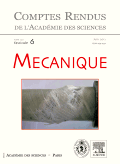
COMPTES RENDUS MECANIQUE
Scope & Guideline
Fostering Collaboration and Innovation in Mechanics and Materials
Introduction
Aims and Scopes
- Mechanics of Materials and Structures:
Research on the mechanical behavior of materials, including fatigue strength, fracture mechanics, and damage mechanics, emphasizing the development of models to predict material responses under various loading conditions. - Fluid Mechanics and Dynamics:
Studies involving fluid behavior, including computational fluid dynamics (CFD) and flow interactions with structures, addressing both theoretical and applied aspects of fluid mechanics. - Mathematical Modeling and Analysis:
Development and analysis of mathematical models for physical phenomena, including PDEs, variational methods, and asymptotic analysis, aimed at understanding complex mechanical systems. - Computational Mechanics:
Application of numerical methods and simulations to solve engineering problems, including finite element analysis and machine learning techniques in mechanics, enhancing predictive capabilities. - Interdisciplinary Approaches:
Integration of mechanics with other fields such as materials science, biology, and environmental science, exploring new applications and theoretical frameworks.
Trending and Emerging
- Machine Learning and Data-Driven Approaches:
The incorporation of machine learning techniques into mechanics research is on the rise, with studies focusing on predictive models and data-driven simulations, reflecting the industry's shift towards automation and intelligent systems. - Microgravity and Space Applications:
Research pertaining to mechanics in microgravity environments is emerging, driven by increasing interest in space exploration and the effects of low-gravity on material behavior and fluid dynamics. - Advanced Material Characterization:
There is a growing emphasis on the development and characterization of new materials, particularly in relation to their mechanical properties and performance under extreme conditions, showcasing innovations in material science. - Coupled Phenomena in Mechanics:
Emerging studies focus on the interactions between different physical phenomena, such as fluid-structure interactions and coupled thermal-mechanical processes, highlighting the complexity of real-world systems.
Declining or Waning
- Classical Elasticity Theory:
Papers focusing solely on classical elasticity without integration of newer computational techniques or experimental validations have become less frequent, suggesting a shift towards more dynamic and computationally intensive approaches. - Static Structural Analysis:
Research centered exclusively on static analysis of structures is declining, as there is a growing emphasis on dynamic responses and interactions in real-world applications. - Traditional Fluid Mechanics:
Studies that do not incorporate modern computational methods or interdisciplinary applications are less common, indicating a transition towards more innovative and complex fluid dynamics research.
Similar Journals

ACTA MECHANICA SINICA
Elevating Research Standards in Mechanical EngineeringACTA MECHANICA SINICA is a prestigious journal published by SPRINGER HEIDELBERG that has been a cornerstone in the field of mechanical engineering and computational mechanics since its inception in 1985. Based in Germany, this leading publication is internationally recognized for its high impact, holding a Q1 ranking in both Computational Mechanics and Mechanical Engineering as of 2023. It is positioned prominently within the academic community, evidenced by its respectable Scopus rankings—#21 in Computational Mechanics and #159 in Mechanical Engineering, both within the 76th percentile. Researchers and professionals alike turn to ACTA MECHANICA SINICA for cutting-edge research, innovative methodologies, and insights that drive advancements in the discipline. Although the journal is not open access, its rigorous peer-review process ensures the publication of high-quality, impactful research that is essential for scholars and practitioners aiming to stay at the forefront of mechanical engineering advancements.
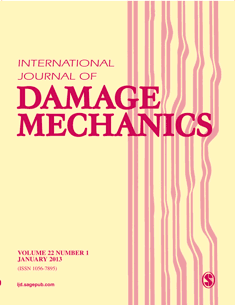
INTERNATIONAL JOURNAL OF DAMAGE MECHANICS
Pioneering Research in Materials ScienceINTERNATIONAL JOURNAL OF DAMAGE MECHANICS, published by SAGE PUBLICATIONS LTD, stands as a pivotal peer-reviewed platform contributing to the fields of damage mechanics, computational mechanics, and materials science. With its ISSN 1056-7895 and E-ISSN 1530-7921, this esteemed journal has charted an impressive trajectory since its inception in 1992 and continues to influence the academic community through its high-quality research outputs. Recognized for its excellence, the journal has consistently ranked in the Q1 quartile across various categories including Computational Mechanics and Mechanical Engineering in 2023, reflecting its critical impact in these domains. It has attained an outstanding Scopus rank of #7/89 in Computational Mechanics, positioning it within the top tier of journals in the engineering discipline. The journal's commitment to advancing knowledge is further underscored by its broad scope that attracts innovative research, making it an essential resource for researchers, professionals, and students alike. Though it operates under a traditional subscription model, readers are encouraged to access its wealth of information, which is instrumental in promoting scholarly communication and driving forward the frontiers of damage mechanics.
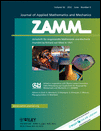
ZAMM-Zeitschrift fur Angewandte Mathematik und Mechanik
Unveiling Innovative Solutions in Applied Mathematics and Mechanics.ZAMM-Zeitschrift fur Angewandte Mathematik und Mechanik is a distinguished journal published by WILEY-V C H VERLAG GMBH, committed to advancing the fields of applied mathematics and computational mechanics since its inception in 1921. With a significant trajectory spanning nearly a century, this journal serves as a critical platform for the dissemination of high-quality, peer-reviewed research that encompasses theoretical and practical advancements in these disciplines. Currently holding a Q3 category in Applied Mathematics and Q2 in Computational Mechanics as per the 2023 rankings, ZAMM demonstrates its prominence with measurable impact in both fields, reflected in its Scopus rankings: 202 out of 635 journals in Applied Mathematics and 32 out of 89 in Computational Mechanics. Although it does not provide open access, ZAMM remains invaluable to researchers, professionals, and students seeking to deepen their understanding and contribute to the evolving landscape of mathematical applications in engineering contexts. Explore the latest insights and methodologies that push the boundaries of applied mathematics and mechanics by engaging with ZAMM’s comprehensive range of articles.

Journal of Mathematical Fluid Mechanics
Pioneering Research in the Mathematical Foundations of Fluid BehaviorThe Journal of Mathematical Fluid Mechanics, published by SPRINGER BASEL AG, is a prestigious academic journal dedicated to the study of fluid dynamics through the lens of mathematics. With its ISSN 1422-6928 and E-ISSN 1422-6952, this journal has firmly established itself in the academic community since its inception in 2004, converging knowledge across various mathematical disciplines until 2024. Recognized in the top Q1 quartile rankings for Applied Mathematics, Computational Mathematics, Condensed Matter Physics, and Mathematical Physics as of 2023, it reflects a strong commitment to high-quality research and innovation. The journal features a variety of research articles, reviews, and theoretical frameworks, serving as an essential resource for researchers, professionals, and students eager to explore the mathematical principles underlying fluid mechanics. While it does not offer open access, the impact of its contributions resonates within interdisciplinary fields, advancing both theoretical insights and practical applications.

Materials Physics and Mechanics
Pioneering New Horizons in Material MechanicsMaterials Physics and Mechanics is a pivotal journal dedicated to advancing the fields of condensed matter physics, materials science, mechanical engineering, and the mechanics of materials. Published by the Institute of Problems in Mechanical Engineering, Russian Academy of Sciences, this journal has established itself as a valuable resource since its inception, particularly from 2003 to 2004 and now continuously from 2009 to 2024. Although it currently holds a Q4 categorization in various disciplines, its contributions are critical to understanding and developing new materials and their applications in engineering. The journal provides insightful articles that explore the nuances of material properties, their behaviors under different conditions, and the physical principles governing these phenomena. Though it operates under a traditional publication model, the insights provided within its pages are invaluable to researchers, professionals, and students striving to push the boundaries of knowledge in the materials domain. Its ISSN numbers (1605-2730, E-ISSN 1605-8119) serve as a gateway to a wealth of scientific knowledge emanating from the Russian Federation, contributing to the global discourse in materials physics and mechanics.

Journal of Applied Mechanics and Technical Physics
Exploring the Dynamics of Material Science and EngineeringJournal of Applied Mechanics and Technical Physics is a distinguished publication that serves as a vital resource for researchers and professionals in the realms of mechanical engineering, mechanics of materials, and condensed matter physics. Published by MAIK NAUKA/INTERPERIODICA/SPRINGER, this journal has been committed to disseminating high-quality research since its inception in 1965. With a noted presence in the academic community, it holds a respectable Q3 ranking in multiple categories as of 2023, indicating its relevance and contribution to the field. Although it does not currently offer open access, the journal provides valuable insights and advancements through its rigorous peer-review process. Covering a broad spectrum of topics in applied mechanics and technical physics, it aims to foster innovation and dialogue among scientists, engineers, and scholars alike. Located in the United States, the journal continues to make significant strides in bridging the gap between theoretical research and practical applications, making it an essential read for anyone engaged in these dynamic fields.
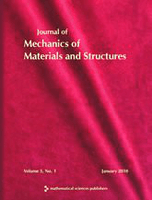
Journal of Mechanics of Materials and Structures
Unveiling New Perspectives on Structural Mechanics.Journal of Mechanics of Materials and Structures, published by Mathematical Science Publishers, is a distinguished periodical in the field of Applied Mathematics and Mechanics of Materials. With the ISSN 1559-3959, this journal has been a pivotal platform since its inception in 2006, providing insights and advancements in the mechanics of materials and their structural applications. Operating out of the University of California, Berkeley, this journal not only boasts a respectable standing within its categories, ranking Q4 in Applied Mathematics and Q3 in Mechanics of Materials as of 2023, but it also serves a crucial role in fostering academic discourse among researchers, practitioners, and students alike. Although it does not currently offer open access, its contributions to the respective fields are invaluable, underscoring the relevance and importance of continued research in understanding material behavior and structural integrity. Whether investigating theoretical frameworks or engineering applications, the Journal of Mechanics of Materials and Structures remains an essential resource for anyone dedicated to the advancement of the science of materials and structures.

MECCANICA
Connecting Ideas in Condensed Matter and MechanicsMECCANICA, an esteemed journal published by Springer, stands at the forefront of research in the fields of Condensed Matter Physics, Mechanical Engineering, and Mechanics of Materials. Established in 1966 and continuing through 2024, this journal provides a robust platform for the dissemination of innovative research and advancements in these increasingly interconnected domains. With an impressive 2023 ranking placing it in the Q2 category across multiple fields, MECCANICA boasts a Scopus rank of #198 in Mechanical Engineering, #150 in Condensed Matter Physics, and #141 in Mechanics of Materials, highlighting its significance and influence within the scholarly community. The journal aims to foster dialogue among researchers, professionals, and students, facilitating the exchange of cutting-edge ideas and methodologies crucial for overcoming contemporary engineering and physics challenges. Readers can access a wealth of knowledge through its comprehensive articles, and while it does not currently offer open access, the journal remains instrumental in shaping the future of engineering and physical sciences.
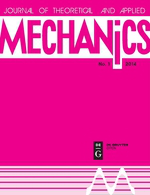
Journal of Theoretical and Applied Mechanics-Bulgaria
Bridging Theory and Application in MechanicsThe Journal of Theoretical and Applied Mechanics-Bulgaria, with the ISSN 0861-6663 and E-ISSN 1314-8710, is a pivotal publication in the field of mechanics, published by the esteemed BULGARIAN ACAD SCIENCES, INST MECHANICS. Based in Germany, this journal serves as a forum for researchers and practitioners to disseminate groundbreaking theories and applications in Computational Mechanics, Mechanical Engineering, and Modeling and Simulation. As of 2023, it is classified in the Q4 quartile for these categories, reflecting its emergence in the academic landscape, though it has room for growth in visibility and impact. The journal encompasses an ambitious scope aimed at fostering innovation and collaboration among academics, making it an invaluable resource for students and professionals seeking to stay abreast of emerging trends and methodologies in mechanics. Despite its current rank and percentile indicators in Scopus, the journal is committed to enhancing its reach and impact within the community through future editions converging from 2016 to 2024. With no open access options currently available, it emphasizes the importance of institutional subscriptions and academic partnerships to maintain its quality publication standards.

Moscow University Mechanics Bulletin
Unveiling Insights in Mechanics of MaterialsMoscow University Mechanics Bulletin, published by PLEIADES PUBLISHING INC, is a dedicated journal that has been influencing the fields of mechanical engineering and mechanics since its inception. With an ISSN of 0027-1330 and E-ISSN of 1934-8452, this journal serves as a crucial platform for advancing knowledge in mathematics, mechanical engineering, and mechanics of materials. Though currently indexed in the Q4 category across these disciplines, it offers a unique space for researchers and professionals to engage with emerging theories, experimental results, and practical applications. With a converged publication history spanning from 1973 to 1987, and continuing from 2007 to 2024, the journal remains relevant in today’s academic landscape. Though it operates under traditional access models, the journal's global reach aims to connect diverse voices in engineering research. Aspiring researchers and seasoned professionals alike will find valuable insights and a robust discourse that contribute to their respective fields.